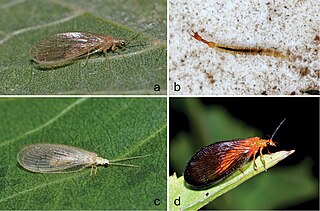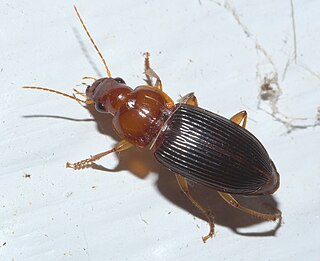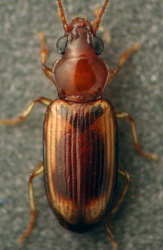
The Nevrorthidae are a small family of winged insects of the order Neuroptera. Extant species may be described as living fossils. There are 19 extant species in four genera, with a geographically disjunct distribution: Nevrorthus, comprising 5 species with scattered distributions around the Mediterranean; Austroneurorthus, with two species known from southeastern Australia; Nipponeurorthus, comprising 11 species known from China and Japan; and Sinoneurorthus, known from a single species described from Yunnan Province, China. They are traditionally placed in the Osmyloidea, alongside Osmylidae and the spongillaflies (Sisyridae), but some research has considered them to be the sister group to the rest of Neuroptera. The larvae have unique straight jaws that are curved at the tips, and live as unspecialised predators in the sandy bottom sediments of clear, fast flowing mountain rivers and streams. They pupate underwater on the underside of stones. The adults are likely predators or feed on honeydew and other sugar-rich fluids.

Peripatopsidae is one of the two living velvet worm families.
Ametroglossus is a genus of ground beetles in the family Carabidae. This genus has a single species, Ametroglossus ater, found in Australia.

Notiobia is a genus of ground beetles in the family Carabidae. There are about 100 described species in Notiobia.
Phorticosomus is a genus of beetles in the family Carabidae, containing the following species:

Demetrida is a genus of beetles in the family Carabidae, containing the following species:

Philophlaeus is a genus of beetles in the family Carabidae, found in Australia and New Zealand. The genus contains the following species:
Calyptogonia is a genus of ground beetles in the family Carabidae. There are at least two described species in Calyptogonia.
Decogmus is a genus of ground beetles in the family Carabidae. This genus has a single species, Decogmus chalybeus. It is found in Australia.

Pseudomorpha is a genus of beetles in the family Carabidae, found in North, Central, and South America.

Notonomus is a genus of beetles in the family Carabidae, containing the following species:
Carenidium is a genus of ground beetles in the family Carabidae. There are more than 20 described species in Carenidium, found in Australia.
Geoscaptus is a genus of beetles in the family Carabidae, containing the following species:

Pericompsus is a genus of ground beetles in the family Carabidae. There are more than 70 described species in Pericompsus.

Pogonus is a genus of ground beetles in the family Carabidae, found worldwide. There are more than 50 described species in Pogonus.

Thomas Gibson Sloane was an Australian sheep grazier and entomologist, considered to be one of the pioneers in Australia's entomology field.
Neonomius ovalis is a species of ground beetle in the family Carabidae. It is found in Australia.

Gracillariinae are a subfamily of moths which was described by Henry Tibbats Stainton in 1854.
Brithysternum is a genus of ground beetle in the subfamily Broscinae. The genus was described by William John Macleay in 1873 with the genus being found in Australia and containing the following species:

Migadopini is a tribe of ground beetles in the family Carabidae. There are about 16 genera and more than 40 described species in Migadopini.











